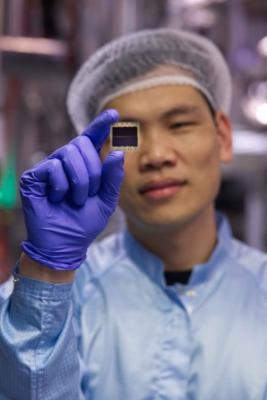Scientists at Oxford University Physics Department have developed thin-film perovskite coatings that could be placed onto the surfaces of everyday objects like cars and mobile phones to generate increasing amounts of solar electricity without the use of silicon-based solar panels.
Dr Shuaifeng Hu, Post Doctoral Fellow at Oxford University Physics, holding the new thin-film perovskite material. Image credit: Martin Small and Oxford University.
The light-absorbing material is said to be, for the first time, thin and flexible enough to apply to the surface of almost any building or common object. Using a pioneering technique developed in Oxford, which stacks multiple light-absorbing layers into one solar cell, they have harnessed a wider range of the light spectrum, allowing more power to be generated from the same amount of sunlight.
This ultra-thin material, using this so-called multi-junction approach, has now been independently certified to deliver over 27% energy efficiency, for the first time matching the performance of traditional, single-layer, energy-generating materials known as silicon photovoltaics. Japan’s National Institute of Advanced Industrial Science and Technology (AIST), reportedly gave its certification prior to publication of the researchers’ scientific study later this year.
"During just five years experimenting with our stacking or multi-junction approach we have raised power conversion efficiency from around 6% to over 27%, close to the limits of what single-layer photovoltaics can achieve today", said Dr. Shuaifeng Hu, Post Doctoral Fellow at Oxford University Physics. "We believe that, over time, this approach could enable the photovoltaic devices to achieve far greater efficiencies, exceeding 45%".
"By using new materials which can be applied as a coating, we’ve shown we can replicate and out-perform silicon whilst also gaining flexibility. This is important because it promises more solar power without the need for so many silicon-based panels or specially-built solar farms", said Dr. Junke Wang, Marie Skłodowska Curie Actions Postdoc Fellow at Oxford University Physics.
"The latest innovations in solar materials and techniques demonstrated in our labs could become a platform for a new industry, manufacturing materials to generate solar energy more sustainably and cheaply by using existing buildings, vehicles, and objects", said Henry Snaith, Professor of Renewable Energy, Oxford University Physics Department.
"We can envisage perovskite coatings being applied to broader types of surface to generate cheap solar power, such as the roof of cars and buildings and even the backs of mobile phones. If more solar energy can be generated in this way, we can foresee less need in the longer term to use silicon panels or build more and more solar farms", Dr. Wang added.
The researchers are among 40 scientists working on photovoltaics led by Professor Henry Snaith at Oxford University Physics Department. Their pioneering work in photovoltaics and especially the use of thin-film perovskite began around a decade ago and benefits from a bespoke, robotic laboratory.




